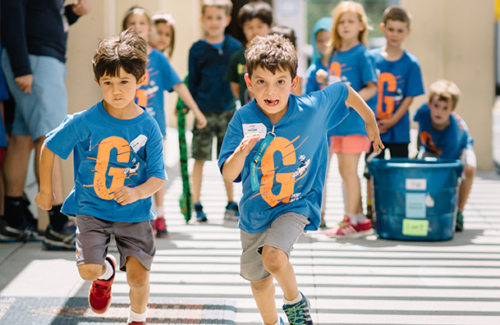KEEPING YOUR KIDS HEALTHY DURING THE SCHOOL YEAR AND FALL-TO-WINTER TRANSITION

Depending on the kid, the thought of going back to school may be met with smiles or groans as they think about another year of friends, homework and activities. Parents, too, often meet the start of school with excitement as well as some anticipation—after all, it’s well known that with the changing seasons and classrooms full of students can come seasonal illnesses. Sickness is a part of life, but this time of year can make kids particularly susceptible and proactively working to stay healthy is crucial.
If your kid has spent the summer playing outside, their immune systems are likely in good shape, as exercise and being exposed to outdoor allergens and germs can help keep their physical states in great working order. But even the healthiest kids face several factors during seasonal transitions that can lead to colds and lost school days. Here are some of the ways you can work to prevent sickness while also using illness prevention as an opportunity to teach your kids about human biology.
KEEPING KIDS HEALTHY DURING THE SCHOOL YEAR
You can’t always prevent illness, but there are a number of important preventative measures that you and your kids can take:
- Get ready for new germs. During the summer, families often travel. Visiting new regions introduces your body to new microbes, and if you are in an enclosed space with people from all over for a few hours, like on an airplane, you may bring home some unwanted guests. To avoid infection, teach your kids about washing their hands before meals and after using the bathroom. They should lather their hands and hold them under the running water for a good 30 seconds, as the force of flowing water can knock germs off of the skin. Put tissues and hand sanitizers in their backpacks. Remind your kids to cover their mouths when they cough or sneeze, or sneeze into a tissue. Then, explain to your kids how microbes spread and about cross contamination. Any place people frequently touch (e.g., the doorknob in their classroom) is a waystation for trading germs.
- Inoculate your family with flu shots. Flu season starts in October and flu shots are available at your doctor’s office and even some local drug stores. Every year there are multiple active flu strains. Scientists have the job of predicting which one will be the most dangerous and widespread for the coming season. Inoculate kids to avoid having sick days from school, spreading the flu to the rest of the family and to spare kids a lot of discomfort. Are your kids curious about why they need to get a shot? Teach them about Louis Pasteur, the microbiologist who discovered vaccination.
- Bundle up for colder weather. Fall and winter bring cooler temperatures. Be sure that kids bundle up in sweaters or jackets that can be easily removed once indoors. If your child has respiratory problems, cover their nose and mouth with a scarf. Their exhallations will warm the scarf, helping to warm the air they inhale. And don’t forget gloves, mittens and socks. Chilly extremities are no fun when on a windy morning waiting for the school bus. You can explain to scientifically curious kids that the idea that cold weather directly causes infections is an old wives’ tale. But, it is true that if your immune system is weakened as a side effect of cold weather, it’s easier to get sick.
- Seek treatment for fall allergies. Fall’s biggest allergen is ragweed, which starts releasing pollen when nights in August cool and can last through October. Mold is another trigger, which can accumulate in piles of dead leaves. The first time you turn the heater on in fall, dust mites can be stirred up in their air, causing sneezes, wheezes and sniffles. One way to protect your kids is to install a HEPA filter in your heating system to clean these allergens from indoor air. Take your kid to the doctor if their allergies are severe. They may be prescribed steroid nasal sprays, antihistamines, mucus decongestants or even immunotherapy. And until you can get to the doctor, grab over the counter allergy medications for short-term relief. Do your kids wonder why they’ve got the sneezes? Teach them about pollen, which is part of a plant’s reproductive cycle. Pollen carries male reproductive cells on the wind to the female parts of other plants. Along the way, your body can encounter pollen and antibodies, mistaking pollen for an invader. White blood cells, the body’s security guards, can release histamines, making your kids feel itchy and sneezy.
- Keep a set bedtime. We all know kids need their sleep to focus and better retain new knowledge. But a rested body also can be much better at fighting off infectious germs. Daylight saving time ends for the year 2018 on Sunday, November 4th. You can get kids ready for this transition by putting them to bed a little earlier the week before.
- Feed kids nutritious meals and pack a healthy lunch. Vitamins, minerals and the phytochemicals found in fruits and veggies perform countless tasks in the body. These include helping reinforce bones, healing cuts, bolstering the immune system, repairing damaged cells and converting food into energy.
- Soothe stress caused by social pressures and academic expectations. It’s not just a placebo effect. Psychological and emotional stress can weaken your child’s immune system, making them vulnerable to infection. There are many ways to help your kids relieve stress. Some kids like to vent their emotions playing video games. Physical exercise is proven to reduce stress, and you can give your kids toys or balls that encourage outdoor play. Schedule play dates for them to socialize with their friends, as having the support of their friends is always important for a young person. And if your kid tells you they are facing social pressures such as bullying, believe them! Take your kids seriously when they tell you about conflicts with other kids at school. Remember, it’s not always easy for kids to speak up, and if they’ve told you about it, it must be important to them. Contact anti-bullying resources and talk to your kid’s teachers and principal to make sure they are getting the attention and support they need.
Sure, kids can get sick any time. But fall and winter tend to be the most challenging. While no kid (or parent!) likes catching a bug, you can try to make the most of the experience by thinking about the how illness and the body interact. Helping your kids explore their curiosity about the natural world and the human body is an amazing way to get them interested in science.

GETTING THE YEAR OFF ON THE RIGHT FOOT
Preventative measures can help protect kids, but if they do still end up ill, remember to keep them home. Sending a sick kid to school doesn’t do anyone any favors. Besides being physically uncomfortable, your kid won’t retain knowledge easily while sick. They can spread germs to the rest of the class, which impacts the learning environment. Keep kids home, let them get their rest and let them enjoy the break. The sooner they get well, the better it is for everyone.
Getting your kids off to a healthy start this fall will ensure they have the best chance of success throughout the year. Good habits will sustain them well into winter when illnesses are at their worst. And as you make these preparations, explain why you are doing them. As you teach your kids the biological causes behind their illnesses and allergies, they receive the best real-world examples of science in action possible. And that leads to strong minds as well as bodies.
To find an exceptional summer camp experience in your area: San Francisco Bay Area,Southern California, and Chicagoland. Sign up for our mailing list to keep up-to-date on our camp happenings, innovation resources and news about upcoming camp registration for summer 2019.

